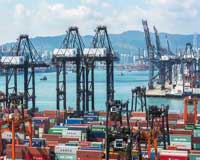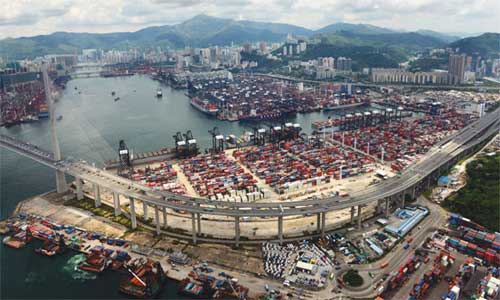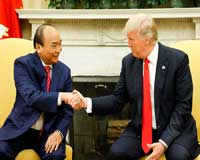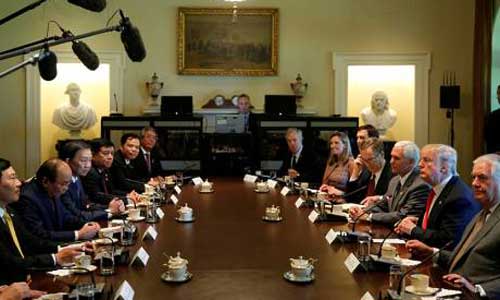FW
"Hong Kong’s export sentiment has reached a four-year high, according to the latest Hong Kong Trade Development Council (HKTDC) Export Index. For the second consecutive quarter the Index rose, climbing to 50.1 during the April-to-June period. The figure registered 47.1 in the first quarter of the year. The results are the first time since the second quarter of 2013 to surpass the 50 mark, reflecting positive sentiment among local exporters. The Export Index gauges exporter confidence, with a reading below 50 signaling a contraction in Hong Kong exports over the short-term."

Hong Kong’s export sentiment has reached a four-year high, according to the latest Hong Kong Trade Development Council (HKTDC) Export Index. For the second consecutive quarter the Index rose, climbing to 50.1 during the April-to-June period. The figure registered 47.1 in the first quarter of the year. The results are the first time since the second quarter of 2013 to surpass the 50 mark, reflecting positive sentiment among local exporters. The Export Index gauges exporter confidence, with a reading below 50 signaling a contraction in Hong Kong exports over the short-term.
However, export growth is expected to moderate in the second half of 2017 due to a higher comparison base, and could be further impacted by major downside risks, including protectionist pressures in the United States, political uncertainties in the European Union, and heightened geopolitical tensions.
Exports index to China, EU up, Japan, US declined

Among individual markets, China surpassed the United States and Japan as the most promising market for local traders. The index for the Chinese mainland market registered 51.9, with the EU up slightly at 49.6, while the index for Japan and the US declined.
Helped by a low comparison base and faster recovery of the global economy, Hong Kong's export performance has so far been above expectations, says HKTDC Principal Economist (Global Research) Daniel Poon. In the first four months of 2014, Hong Kong exports to the US rose 1.3 per cent, those to the EU were up three per cent, and those to Japan increased 5.3 per cent. While Hong Kong exporters are advised to intensify their sales efforts to capitalise on growing opportunities in the developed world, they should not overlook emerging economies, which are expected to continue to do well over the medium term.
Apparel export positive, but clouded by competition
Although China is experiencing slower growth in the midst of economic restructuring, Hong Kong exports to the mainland and ASEAN grew 10.3 per cent and 8.6 per cent respectively. Poon expected a brighter outlook for several industries for an optimistic prospects for overall exports including clothing, which is improving as a global trade environment and should stimulate sales, but prospects will be clouded by continued competition from neighbouring countries such as Vietnam, Cambodia, Myanmar and Bangladesh.
Hong Kong manufacturers looking to relocate or diversify their mainland production base should consider the Philippines as an alternative location. According to Dickson Ho, HKTDC Principal Economist (Asian and Emerging Markets), the country’s skilled workforce and burgeoning retail market offer both manufacturing and sales opportunities.
As a manufacturing base, the Philippines, enjoys a distinct edge compared with other relocation hotspots in Southeast Asia, with its English-speaking workers, who are both skilled and trainable, this presents an attractive option for foreign investors confronted with the challenge of labour management and training in alternative production bases, says Ho.
During a recent trip to Manila, HKTDC Research team found that businesses were optimistic about the country's future development. Ho says that they were generally supportive of the government's economic policy and believed President Rodrigo Duterte's strong government could better tackle the long-standing problems of red tape and bureaucracy in the Philippines.
"To sustain its export-driven economy and minimise the impact of US withdrawal from the TPP, Vietnam is placing a great thrust on the increased trade relations with the US, which is its largest export market. Vietnam and the US have recently signed business deals worth US$8 billion, in the sectors such as aircraft engines and development of power generation capabilities, along with hospitality, science and technology, academia and energy."

To sustain its export-driven economy and minimise the impact of US withdrawal from the TPP, Vietnam is placing a great thrust on the increased trade relations with the US, which is its largest export market. Vietnam and the US have recently signed business deals worth US$8 billion, in the sectors such as aircraft engines and development of power generation capabilities, along with hospitality, science and technology, academia and energy. The trade tie is expected to generate 23,000 American jobs and help in reducing the US trade deficit with Vietnam, which stood at almost US$32 billion in 2016.
Trade stats

Trade between the two countries has been witnessing 20 percent growth annually since 2001, with 2016 trade reaching US$47 billion – 33.5 times higher than 2001 figures. Vietnam is US’s 16thlargest trade partner and the fastest-growing market for US exports. Trade between the two nations is however tilted towards Vietnam. In 2016 and 2015, Vietnam’s trade surplus stood at US$32 billion and US$31 billion respectively. In the first four months of 2017, US accounted for 20 percent of Vietnam’s exports, an increase of 8.7 percent from the same period last year. Major export items included textile-garment, footwear, computers, seafood, farm products, timber and timber products, electronics and components.
Deals sealed in 2017
In the recent exchange, deals worth U$8 billion were signed between the two countries. General Electric signed its largest single combined sale with the country worth US$5.58 billion for power generation, aircraft engines, and services. The agreement includes 20 jet engines made by CFM International, a joint venture of GE and Safran for VietJet Aviation. Also included is a 12-year engine service contract for 100 Boeing 737 MAX aircraft that VietJet has ordered. VietJet also signed a US$1 billion deal with GE Capital Aviation Services for aircraft financing.
In the power sector, GE signed an MoU to build two 750-megawatt gas-fired turbine power plants in conjunction with state energy group Petro Vietnam. The deal also included joint development agreement for an 800-megawatt wind power facility. Caterpillar and its Vietnam subsidiary agreed to provide generator management technology for more than 100 generators in Vietnam. The remaining deals focused on hospitality, science and technology, academia and energy.
TPP without the US
As is the known fact that Vietnam would have been one of the major beneficiaries of the original TPP’s reduced tariffs. TPP including US would have led to an increase in US investments and help Vietnam position itself as a viable alternative to China for low-cost manufacturing. However, with the new US administration favouring bilateral trade deals rather than multilateral, few TPP member countries are pushing to revive the agreement without the US.
Vietnam had brought in changes in state-owned enterprises and deregulated key sectors such as finance, telecommunications, and retail to gain increased access to the US market. Even without the US, Vietnam believes that a renegotiated TPP will be feasible as TPP focused not only on market access, but also on labour reforms, transparency, IP protection, and anticorruption, which would help modernise its economy. The country will also benefit from increased market access in new members and a deeper integration in global supply chains. TPP11 will allow member states reduce their dependence on China, which backs the Regional Comprehensive Economic Partnership (RCEP), which is a 16-nation trade pact that includes the Association of Southeast Asian Nations (ASEAN), along with China, Australia, India, Japan, South Korea, and New Zealand.
Trade outlook
Trade experts predict exports to grow over 13 percent in 2017 driven by acceleration in global trade and higher import of raw materials and electronic parts. Largest export markets will continue to be the US, EU, China, and Japan accounting for 22 percent, 18 percent, 12 percent, and 8 percent respectively of total exports.
Export revenues of Vietnam’s textile and garment industry are forecast to go up 11 per cent over the previous year. Such a number if realized will account for 16 per cent of the country’s total outbound sales.
Vietnam, one of the five largest textile and garment exporters in the world, got 28.3 billion dollars in outbound sales last year. The added value was still not high as local content in its apparel products was just over 50 per cent.
The domestic sector is strong in export outsourcing but weak in weaving and dyeing. Only a small number of Vietnamese enterprises are well-qualified to enter global supply chains. Supporting industries for the local textile and garment sector have remained underdeveloped. It is now facing a lack of skilled workers while its input costs are high and loan interest rates are higher than in other regional countries.
Vietnamese textile and garment products are up against fierce competition with those from other countries, especially China, because in addition to quality, price and delivery time, domestic exporters have to meet strict environmental protection requirements.
Therefore, local manufacturers have had to replace old equipment to meet four key criteria – productivity, quality, energy saving and environmental protection.
Burberry’s chairman Sir John Peace is planning to leave. Peace has been chairman of the luxury fashion retailer since 2002.
A successor will be announced by the end of 2018. Meanwhile Christopher Bailey, who had been combining the role of chief executive and chief creative officer, will step aside and become president of the iconic British brand.
It is not clear whether the departure of 68-year-old Peace from Burberry will mark the end of a long career in the boardrooms of some of the UK’s biggest companies. At one point, he chaired three major businesses – Burberry, the credit-checking company Experian and Standard Chartered bank.
Marco Gobbetti will become chief executive next month after being recruited from French luxury rival Céline. His appointment is one of a number of senior management changes at the company, which recently hired Julie Brown from the medical supplies group Smith & Nephew as chief operating officer and chief financial officer.
Founded in 1856, Burberry is a global luxury brand with a distinctive British identity manufacturing clothing, fragrance and accessories. It is known for its iconic trench coat, sweaters, jackets, backpacks, and the unique and recognizable tartan pattern. The brand has a heritage of innovation, craftsmanship and design.
Advanced Functional Fabrics of America (AFFOA) a public-private partnership that began at MIT, has officially opened its headquarters in Cambridge. CEO Yoel Fink at the headquarters’ opening ceremony stated that a new high-tech fabric center has actually developed that technology and fabrics those convey the identity as individuals and our values as a society.
The Cambridge headquarters has space for startups, workforce development and product prototyping.The $10 million center is located near MIT, which last year founded AFFOA after the federal government tapped Massachusetts to lead a national textile manufacturing innovation institute. Other centers are also planned.
The centre looks like a gigantic laboratory inside. The walls are white with floor-to-ceiling glass partitions. Twenty-foot-tall machines spit out long tiny fibers. Those fibers go on a spool. Think of it as high-tech yarn spinning.
The space will have three main functions a startup incubator and provide tools and guidance to emerging companies, other to focus on education and opportunities for students to get involved in this emerging field. AFFOA is collaborating not only with startups, but also with universities both in the commonwealth and across the country, from UMass Lowell to Drexel University to the University of Texas at Austin and more. The institution is also working with large-scale companies, like Boston’s own New Balance.
To Fink, who is also a professor of materials science and engineering at MIT, fabric is “the new software.” The big idea here is to develop fabrics that provide services.
The invention AFFOA unveiled is a backpack made out of fabric that allows people to upload photos, videos or other information into it using an app called AFFOA Looks. Someone else with the same app can then hold their phone up, scan the backpack and pull up what the backpack owner has uploaded. It works sort of like a QR code.
It's like having a social media platform embedded into fabric. There could also potentially be some advertising and marketing applications.
Apparel manufacturers from Mauritius will participate at Fashion SVP, UK, June 27 and 28. Thirteen manufacturers comprising four large enterprises and nine SMEs will be showcasing to UK buyers their latest collections of a wide range of products including T-shirts, shirts, knitwear, denim, and jersey wear.
Fashion SVP is Europe's unique sourcing event, with an international show presenting over 120 leading fashion producers from the UK and 21 overseas countries, as well as training seminars, trend focus features, product demonstrations, fashion clinics, a jobs' forum and prime networking with the fashion industry. The fair attracts buyers from large famous European retailers to smaller chains, clothing brands, wholesalers and boutique labels.
The textile and apparel industry has been a major contributor to Mauritian GDP. The UK remains an important market for Mauritian exports, accounting for over 15 per cent of total domestic exports. Mauritius has been working with top UK retailers such as Arcadia Group, NEXT, Debenhams, Harrods, and River Island, among others.
To further encourage exports Mauritius has introduced the speed-to-market scheme which is being implemented by Mauritian enterprises. The aim is to give a boost to textile and apparel exports to European countries and to enhance product delivery in terms of speed-to-market.
Marks & Spencer has been the first mover in the retail sector on supply chain sustainability, the venerable UK department store chain, which operates about 1,000 locations across Europe, Asia and the Middle East, says it is pushing even more boundaries. A decade after its first “Plan A” sustainability commitments, M&S is setting 100 new targets to be reached by 2025.
For M&S, the evolution of its sustainability plan is not just about social and environmental sustainability. As is the case with much of the world’s retail sector, this is also about remaining sustainable economically. If M&S cannot thrive financially, then neither can many of the workers within the farthest reaches its supply chain.
Community engagement sums up the first of the three pillars that largely define M&S’ 2025 targets. Well-being is another pillar, one that M&S says it hopes to improve the lives of 10 million people in the UK and abroad over the next eight years. M&S says key to this objective is sourcing 50 critical raw materials that come from sources respecting ecosystems, animals, communities and people.
Finally, “caring for the planet” rounds out the third pillar of M&S’ recharged sustainability program. M&S has outlined its goals in minute detail, the challenge of M&S how to remain relevant in consumers’ lives as shoppers migrate away from brick and mortar onto computers screens and smartphones.
Jockey’s brand campaign features former Navy SEAL and actor Remi Adeleke. The campaign introduces Remi wearing Jockey in a personal, intimate video and a series of portraits illustrating what's underneath, both literally and figuratively.
Remi was born in West Africa. But the Nigerian government seized his family's assets driving Remi and his mother to relocate to the US. The void left by his father's death led Remi to fall in with the wrong crowd and after years of no direction, Remi joined the Navy and became a SEAL, making it through a program that only about 15 to 20 per cent of trainees complete.
During his 13 years on active duty, Remi found his faith and eventually became a youth pastor and motivational speaker. He has a role in the blockbuster Transformers: The Last Knight.
The Jockey brand campaign has shared the powerful stories of Chris Van Etten, a US Marine veteran who shows perseverance always wins; Lisa Cusimano, a firefighter who defines courage as serving something greater than yourself; Michael Cottone, an adoptive father who exemplifies the gift of family, and Michaela DePrince, a war orphan turned ballerina who demonstrates that with hope, anything is possible.
American brand Jockey’s apparel products are sold in major department and specialty stores in more than 145 countries around the world.
JD, China's number two e-commerce firm, will invest 397 million dollars in fashion retailer Farfetch to expand its luxury offerings. JD is locked in fierce competition with Alibaba for China’s high end retail market.
JD will become a major shareholder in the UK firm. The partnership will combine the Farfetch brand and curation with the scale and influence of the foremost Chinese e-commerce giant.
Farfetch will be integrated into JD's existing logistics and marketing systems and the former will also employ JD's online finance tools, including its payment service and microcredit feature.
The deal comes as JD is looking to broaden its offering of luxury and branded consumer goods. Its largest domestic rival Alibaba has expanded heavily into branded goods with its online marketplace Tmall.
JD initially gained popularity as a retail platform for electronics and appliances, but it has since leveraged its extensive in-house logistics network to expand into a range of products including grocery, apparel and on-demand services.
JD has a high-end delivery service, JD Luxury Express, where staff in suits and white gloves deliver packages directly to customers’ homes using electric vehicles.
Online UK fashion retailer Farfetch has partnered with 700 global luxury brands and boutiques.
India and Australia will collaborate in the textile, clothing and fashion sectors. Appropriate measures will be identified to connect the Australian and Indian textile and fashion sectors; promote collaboration and international engagement between those sectors; nurture the skills and talents within those sectors; promote economic opportunities and encourage professional engagement, training, skill development and public exhibition of products derived from these sectors in the two countries. However, Intellectual Property Rights of either side will stand protected.
For overall development of the handloom sector, the initiative aims to increase handloom fabric production by way of establishing market linkages, encouraging innovation in designs and techniques for improvement in design capability, diversification of product lines and value addition, facilitating better access to domestic and export markets so that weavers are able to get continuous employment and improve their living standards.
Australia is emerging as an important market for Indian textiles and handicrafts. Australian fashion designers are interested in working with the textile and handloom sectors in India. Major department stores in Australia source from India.
Exports of Indian handicrafts to Australia have been only 1.31 per cent of India’s total exports of handicrafts. Australia is a small but high-end market where buyers are willing to pay for quality.












